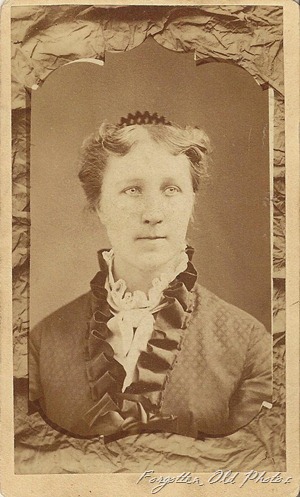This is another CdV from the antique shop in Detroit Lakes Minnesota.
This is an unusual photo treatment. It is like it is a photo of a photo. It is all one piece.
This lady may be Mrs. A. Odegard.
There are many notations. Mo 418, Minneapolis Tribune Co. and Mrs. A. Odegard Cor. Chestnut Street + 9th Ave. Grand Forks, N. Dak. and JAJ 1.50 ( Johns mark and the price 1.50 for the card.)
The photographer was A. F. Burnham of Fairbault Minn. he was in business during the years 1878, 1884 and 1895. I will pick 1895 for the date of this photo because North Dakota did not become a State until 1889… before that time it was known as the Dakota Territory.
Thanks for stopping by, do come again:)



Very interesting. Love the dress and the haircomb.
ReplyDeleteVery unusual and I admire her attire.
ReplyDeleteIt seems unusual to me to place an address with a name - unless it was to be delivered?
ReplyDeleteThere are a several Odegard families living in Grand Forks, ND back in 1900 (and there still are) - but none of them Odegards seem to be old enough to be this woman.
There is an Albert (b. 1861) and Anna (b. ?) Odegard that divorced sometime before 1920... living in Minneapolis MN in the 1930s. He apparently served in WWI - from North Dakota.
I ran across that same type of photo treatment in one of my Tully ancestor's photo collections--makes it look like a picture of a picture frame. I wonder if it was a device used by different photographers of the time--although rare, since I've only seen it once before.
ReplyDeleteShe seems a rather handsome subject...I like the hair in particular, but the overall effect is nice. Do hope someone figures out who she is!
FWIW, Ødegård is a Norwegian name. You find farms called Ødegård all over Norway.
ReplyDelete(It usually means that this farm was left during the Black Death (when half the Norwegian population died), and inhabited again many years/centuries later. It literally means "deserted farm". )
I have seen something similar but not exactly like this. It is an unusual treatment. Maybe something the photo was trying out? It obviously didn't catch on because it's not very common.
ReplyDeleteA comment to anonymous' comment:
ReplyDelete'Ødegård' can mean that the farm was/is far from other farms and towns, not necessarily deserted.
But this is not the topic, is it?
Dr. Jeff: I agree that the literal meaning of Ødegård could indicate a farm that is far away from other farms. However, I would think that very few farms has the name Ødegård in that sense, although most farms called Ødegård probably are somewhat remote.
ReplyDeleteAround 1300 there were around 60 000 farms in Norway. In the beginning of the 1400, 36 000 - 37 000 of these were left ("lå øde", in Norwegian). Such farms were called "ødegård".
When (most of) these farms were cleared again around 1500-1600, the original farm names were often lost, and many of them kept the name Ødegård (or variants, such as Ødegården, Aunet, Aunan, Øyjord, etc.)
http://snl.no/ødegård
But way off topic...